How To Tell If A Moth Is Male Or Female
While hiking at Tar Hollow this past weekend, we spotted a Luna moth perched on a burnt tree trunk. After studying its photograph I realized that we now had photos of both the male and female Luna moth, so I thought I would share with you how to tell the divergence between the two genders, plus provide a niggling background information on this moth. Still when I showed the photo to another people, they were before long telling me that the moth looked similar it was virtually ii feet wide. So before going on, endeavour clicking on the photo beneath to behold its immense size.
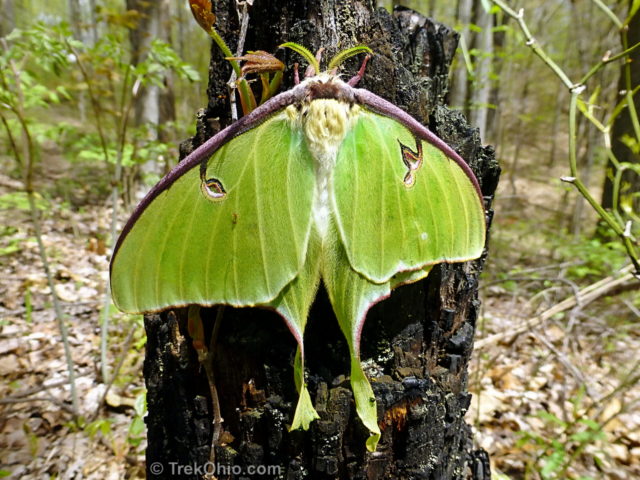
Every bit it turns out, the Luna moth is a actually large moth, simply no, it's not two-anxiety wide. The wingspan typically varies from 3 to 4½ inches, although according to Wikipedia there was one sighted that had a wingspan of 7 inches. The problem with the above photo is that there'due south cipher to provide scale, so I took some other photo of the moth with a friend'due south hand held nigh it, so you could compare sizes.
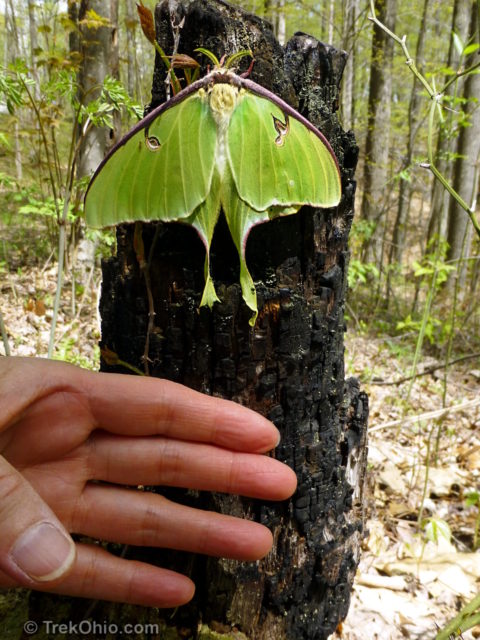
Then the Luna moth pictured in the in a higher place two photos is female, while the Luna moth pictured below is male. Attempt comparison the two to see if you can spot a physical deviation that distinguishes the 2 genders.
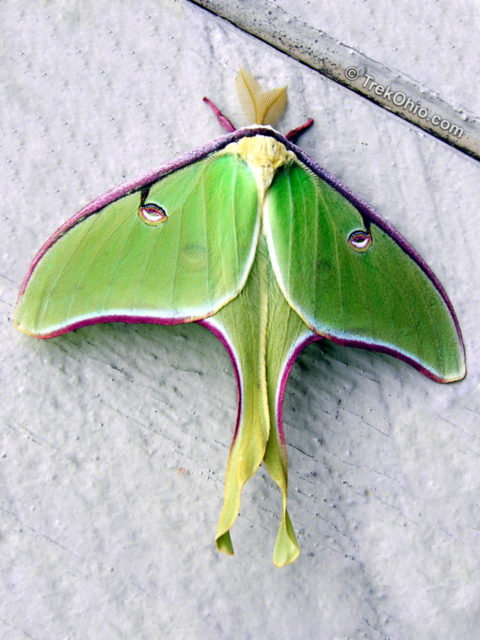
If y'all noticed a departure in the wings, you lot have sharp eyes, but that's because the female that I photographed at the meridian had some sort of mutant variation on its right wing. A lot of moth species have what are known as eyespots on their wings. The idea is to trick potential predators into thinking that they are looking at the head of some large animal. The eyespots on the forewing (the ones on height) are supposed to look like the one on the left. Something crazy happened to the one on the right that kind of ruined the unabridged play tricks.
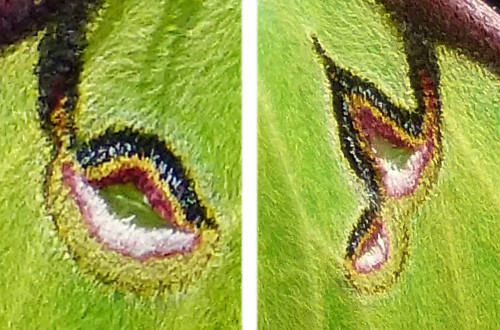
As it turns out, the hindwings (under and to the rear of the forewings), also have eyespots, potentially creating fifty-fifty more confusion. I have not had an opportunity to photograph a Luna moth with its wings spread wide enough to see them, so I'yard going to share a photo published by Julie under a Artistic Commons license.
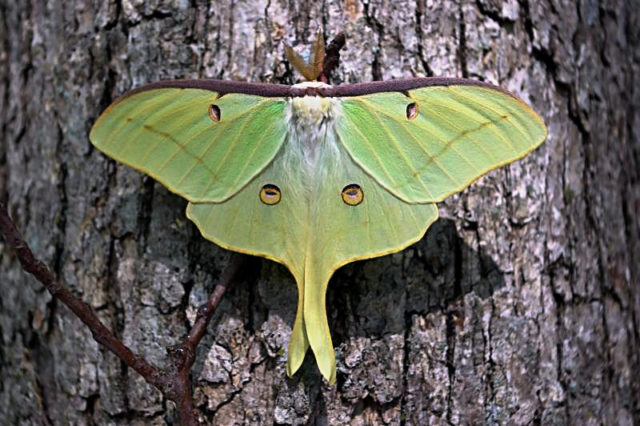
Luna moth with its wings spread broad
And so now that nosotros've got the eyespots out of the way, when yous are trying to distinguish between the two genders what y'all really want to exist looking at are the antennae. The male person has wide, luxuriant antennae, while the female has narrow, spindly little things. Below yous tin come across a side-by-side comparison.
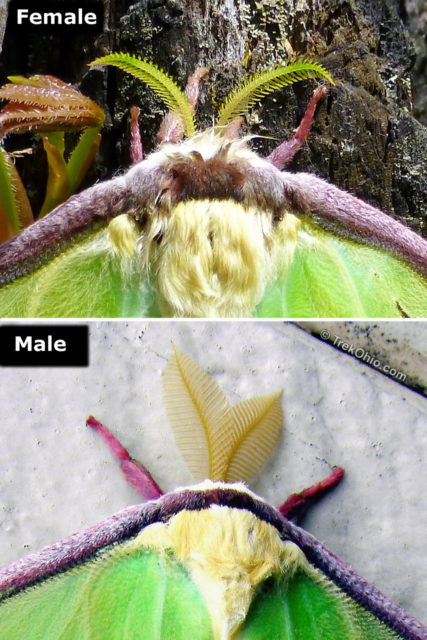
The differences between the two gender's antennae reverberate the species' reproductive strategy. When the Luna moth caterpillar is fat and happy, it buries itself in foliage litter and makes a cocoon under the leaves. Later on transforming into an adult moth it digs itself out of the leafage litter and climbs upward a nearby object. At beginning its wings are wet and rumpled. It has to beat them open up and dry them. And here's where the first behavioral difference betwixt the male and female person moths emerge.
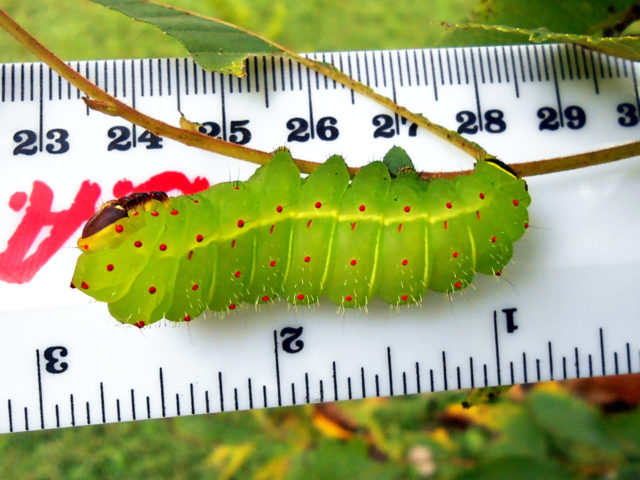
Luna moth caterpillar
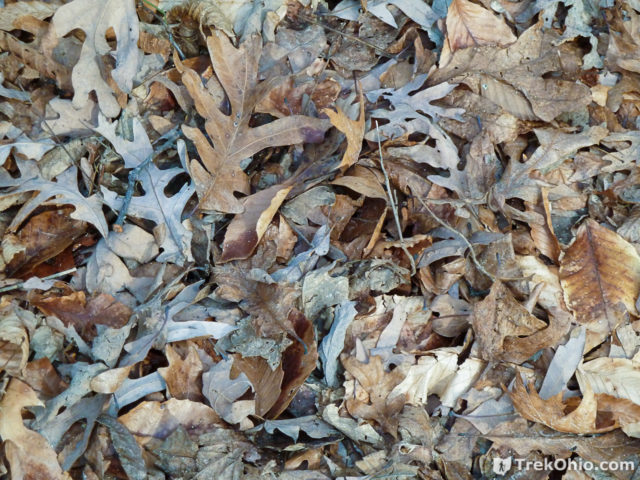
Once the female moth's wings are dry and fully extended, she doesn't fly anywhere. She stays exactly where she was when her wings dried. What she does kickoff doing is pumping out pheromones to signal to a male that she's prepare to mate. The male's antennae are wide and luxuriant because he uses them to find the source of the female pheromones wafting through the air. Since the male does all the seeking while the female stays put, her antennae are not equally developed as his.
Later on mating some other behavioral difference distinguishes the male and female moths. The female person stops emitting pheromones and will never mate again. In contrast the male will fly well-nigh trying to find and mate with additional females. He has virtually a week to find every bit many females equally he can. Why such a short time? He's got a wee, picayune, vestigial mouth and no digestive tract. Equally an adult moth he will subsist entirely on fat that he laid downwards while he was a caterpillar. When he exhausts this store in nearly a week he will die. Although Luna moth are a fairly common moth, they are rarely seen because their lifespan in their adult class is and so brief.
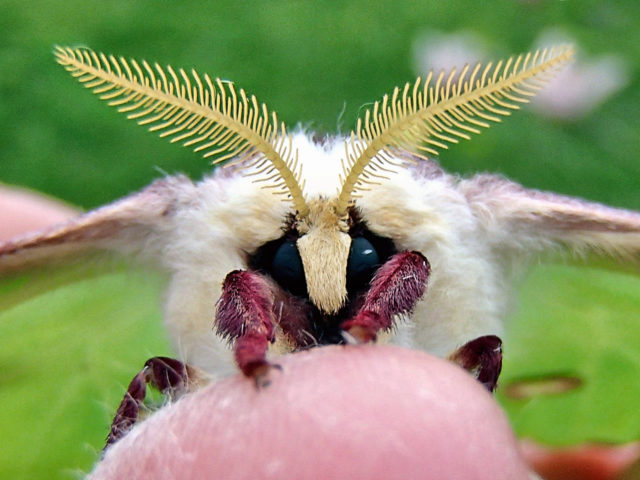
Face up of male luna moth; he has a tiny, useless rima oris.
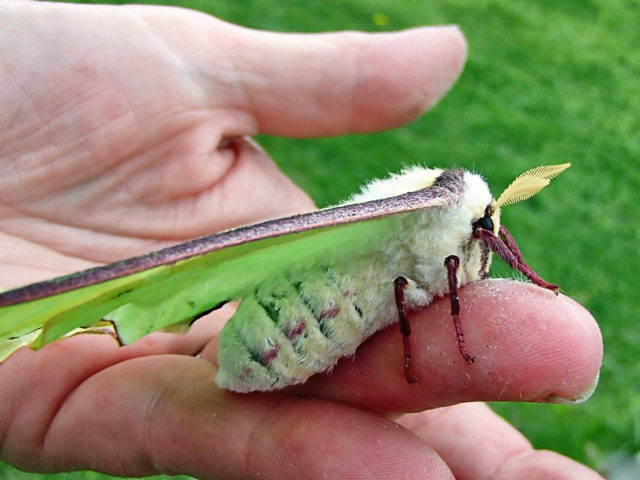
What a fat body this male moth has, and he'southward going to need that fat because he can't eat.
While the male Luna moth continues looking for females, afterwards mating the female Luna moth flies for the first fourth dimension. Her mission for the last week of her life is to distribute her eggs far and wide. She volition lay 4 to 7 eggs on the underside of a leafage, move on to some other leaf and repeat this process until she has laid 400 to 600 eggs in total. The trees and plants where she lays the eggs are called the host plants. For the Luna moth these host plants include alder, reddish, walnut, hickory, oak, elm, linden, poplar, willow, sugariness mucilage, birch, butternut, beech, chestnut, pecan, hazelnut, and persimmon. With such a wide diverseness of host plants to cull from, you'd recollect they'd be everywhere. Nevertheless for reasons that are non fully understood, it is believed their population has been declining in cities and larger towns. Your best bet for seeing one is in forests and suburban areas with large copse.
In Ohio the Luna moth tin comport out two reproductive cycles per twelvemonth. They overwinter as pupae in their cocoons buried in foliage litter beneath the snow.
Additional data
- Wikipedia: Actias luna — this is the scientific name for the Luna moth.
- Wikipedia: Saturniidae — this is the family unit of moth species to which the Luna moth belongs.
- ODNR: Moths of Ohio field guide (PDF)
- Pawnation: Divergence Between Male & Female Luna Moths
- Jim McCormac in the Columbus Dispatch: Luna: big, beautiful moth
- Facebook Group: Mothing Ohio
- Photo series showing moth emerging from leaf litter – posted to the Facebook grouping, Mothing Ohio, past Susan Moore
More on Butterflies and Moths
© Deborah Platt, Robert Platt and TrekOhio.com 2012 to 2021
Share the post "The Luna Moth: Male and Female"
Source: https://trekohio.com/2015/05/06/luna-moth-male-female/#:~:text=So%20now%20that%20we've,side%2Dby%2Dside%20comparison.

0 Response to "How To Tell If A Moth Is Male Or Female"
Post a Comment